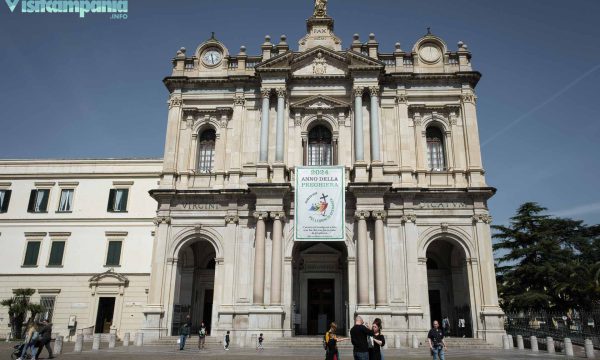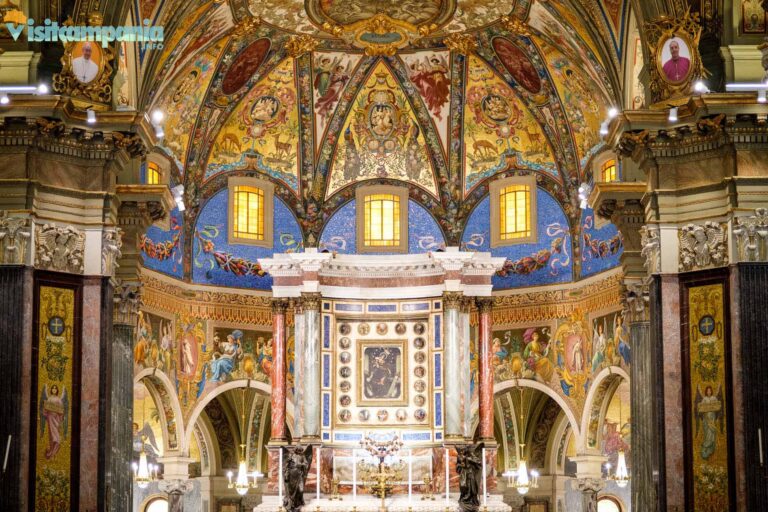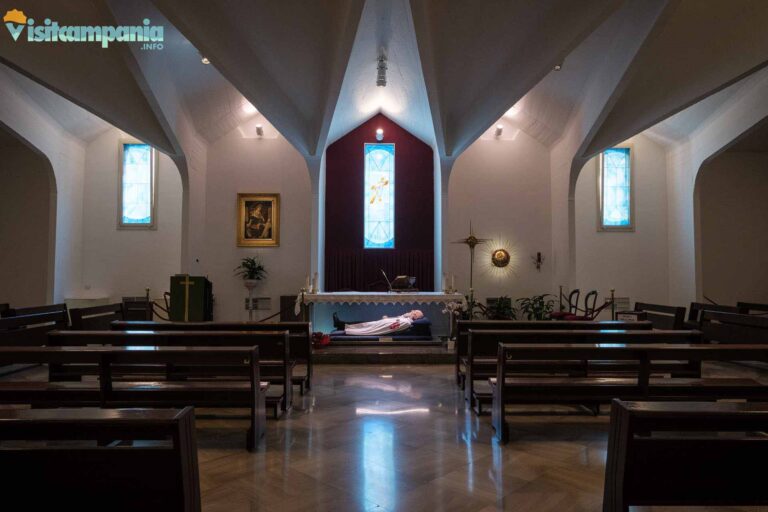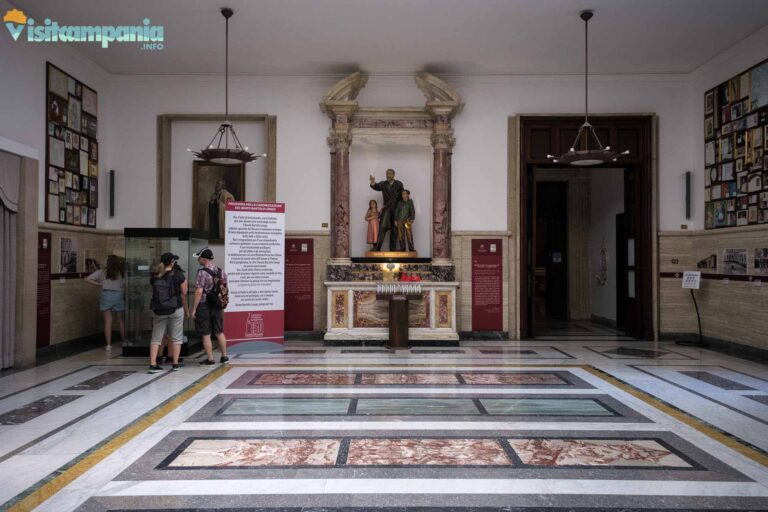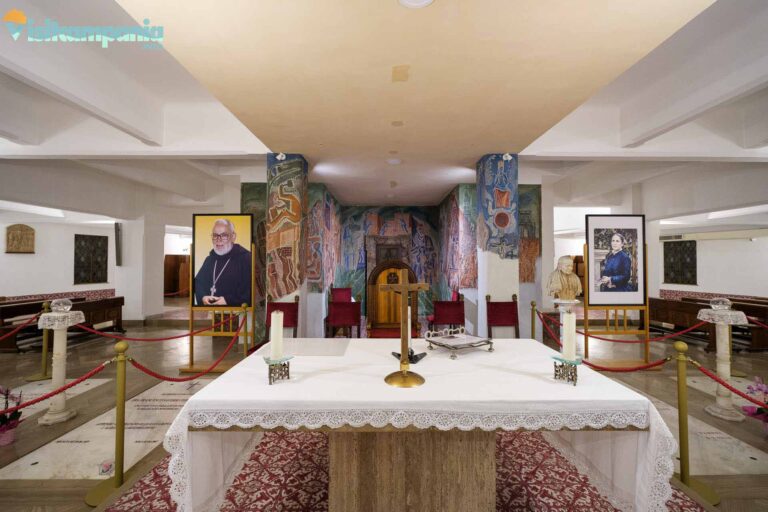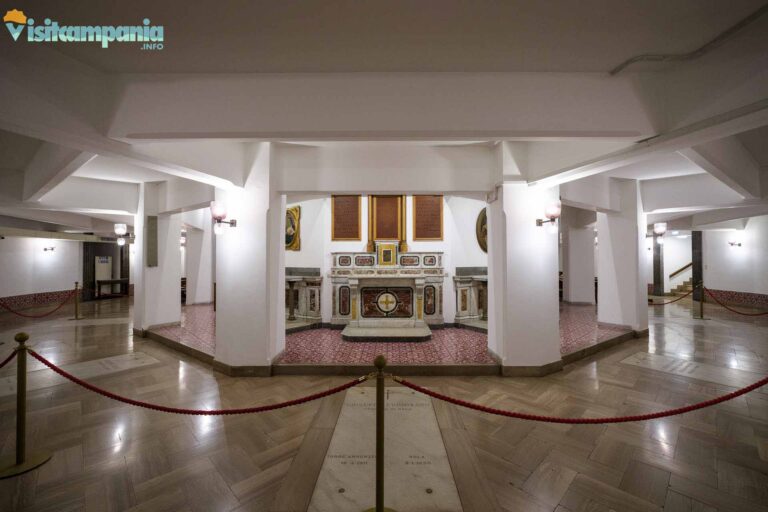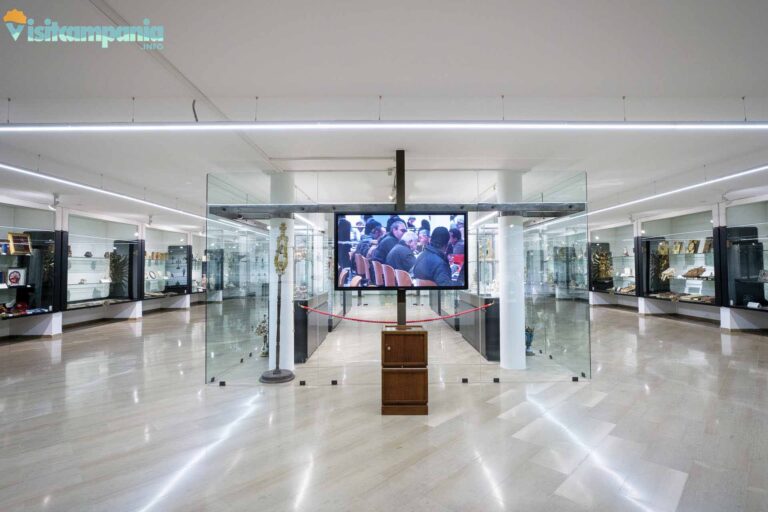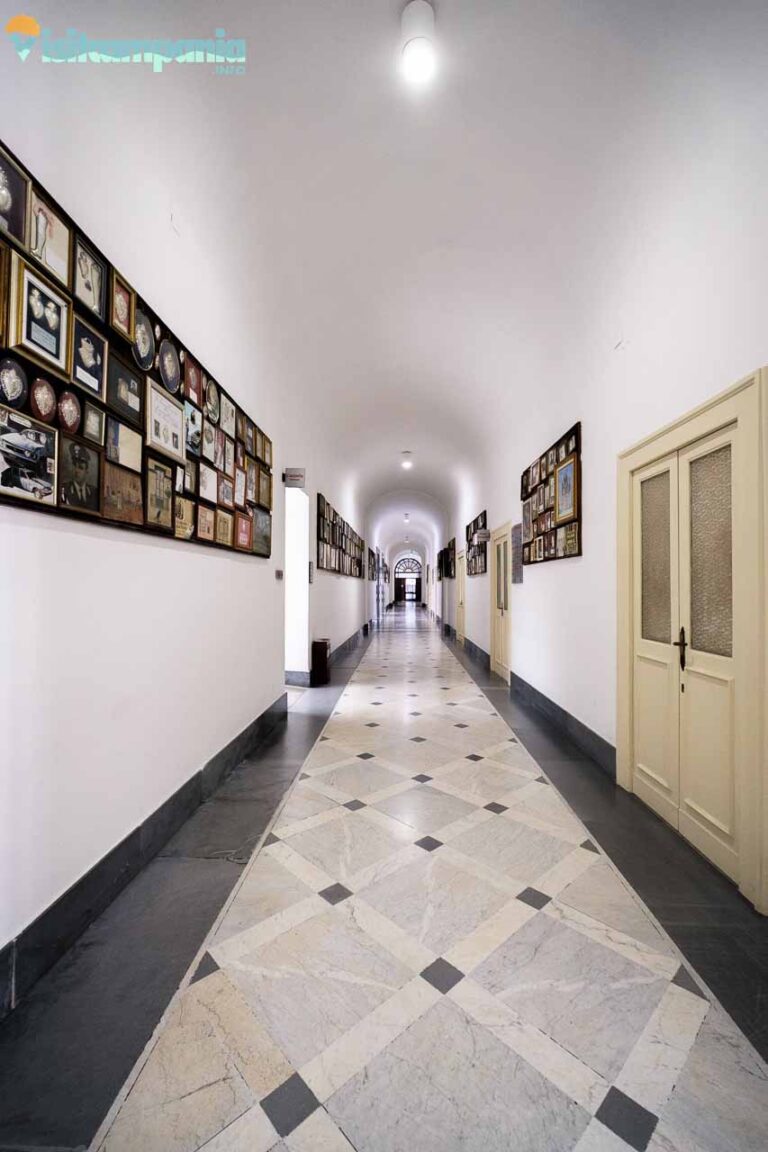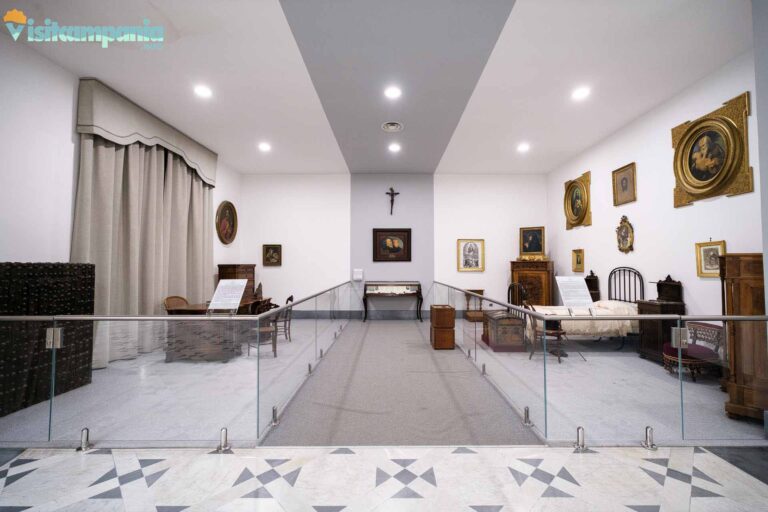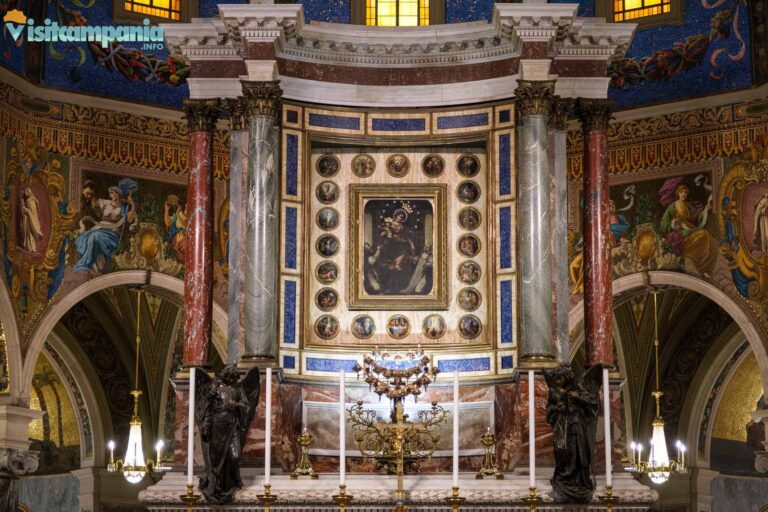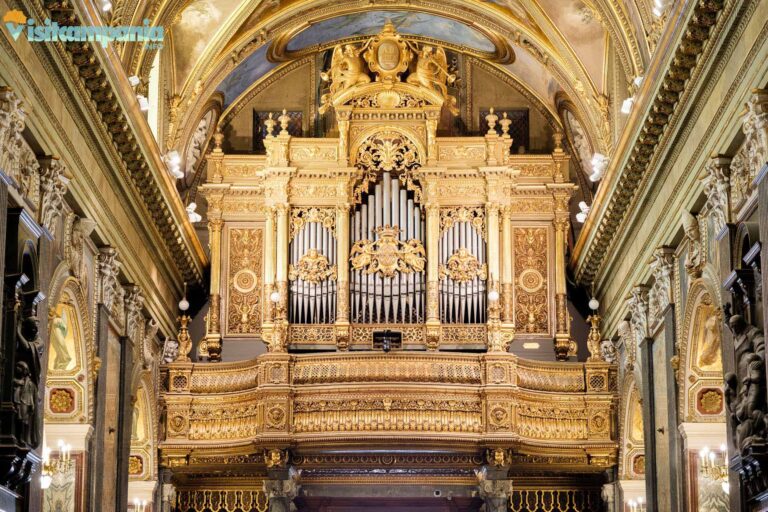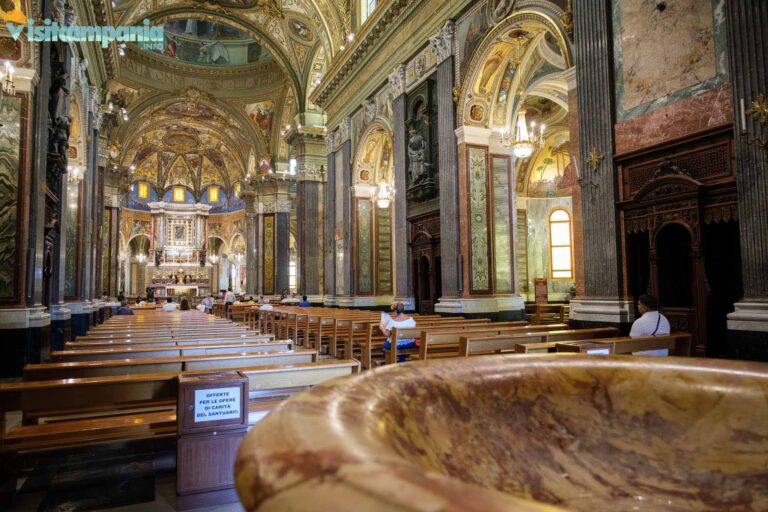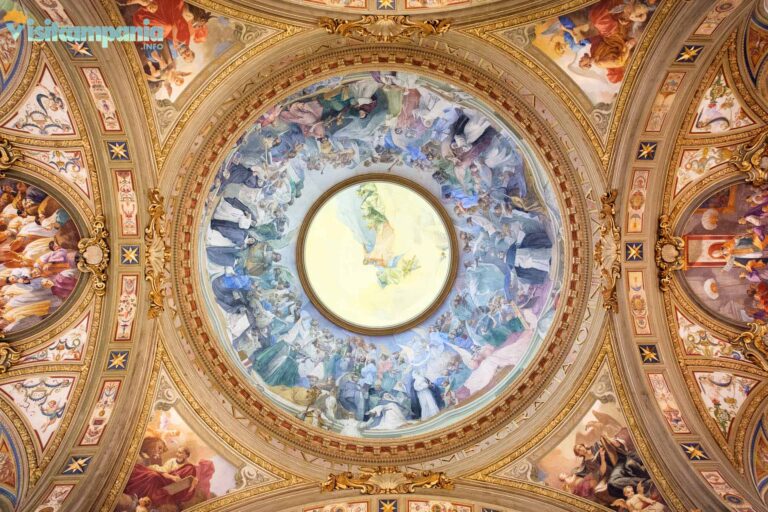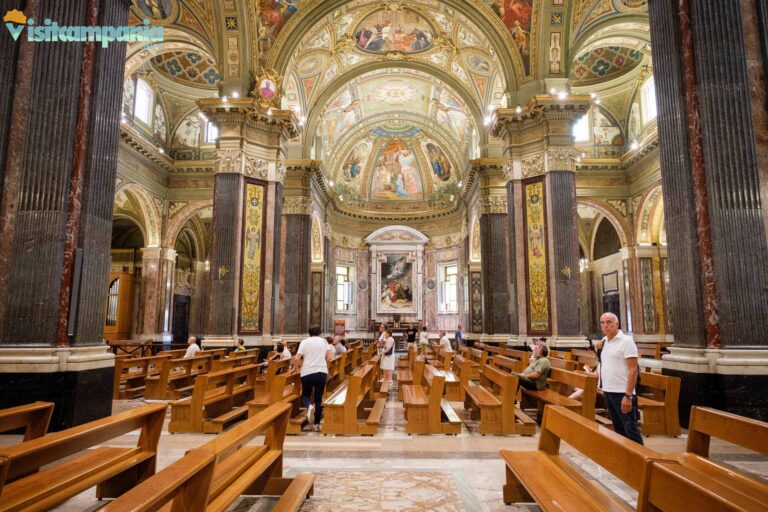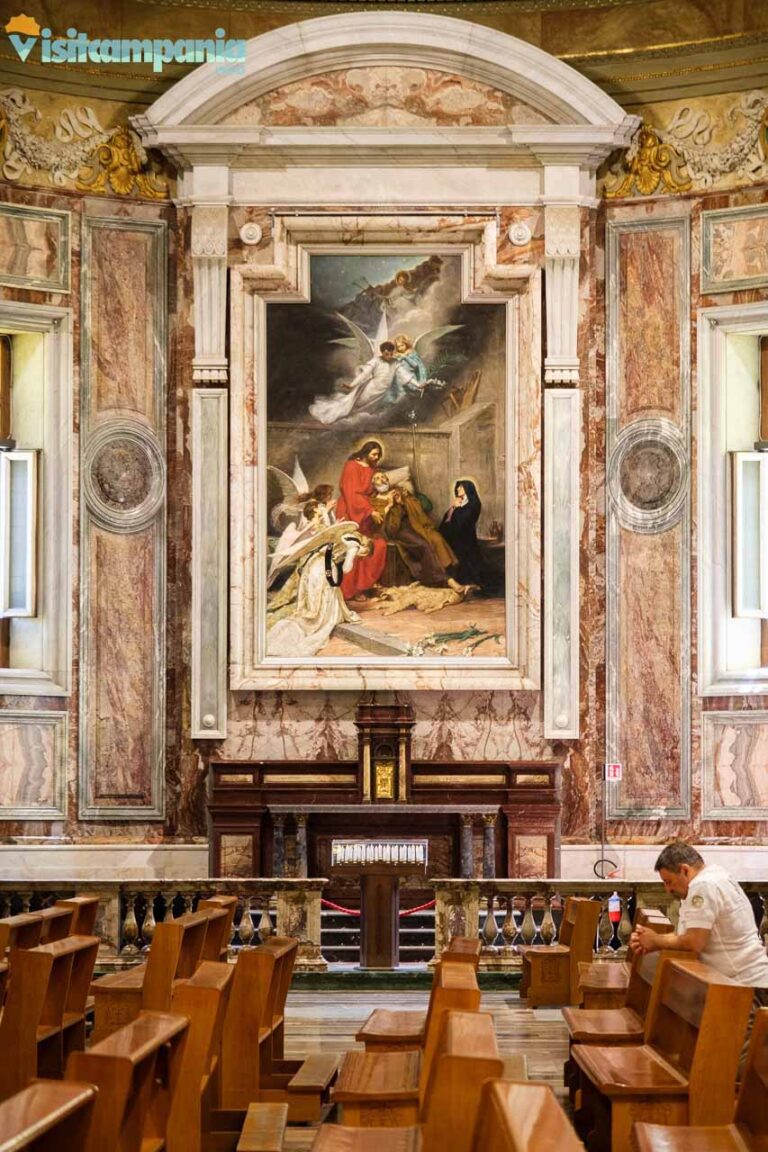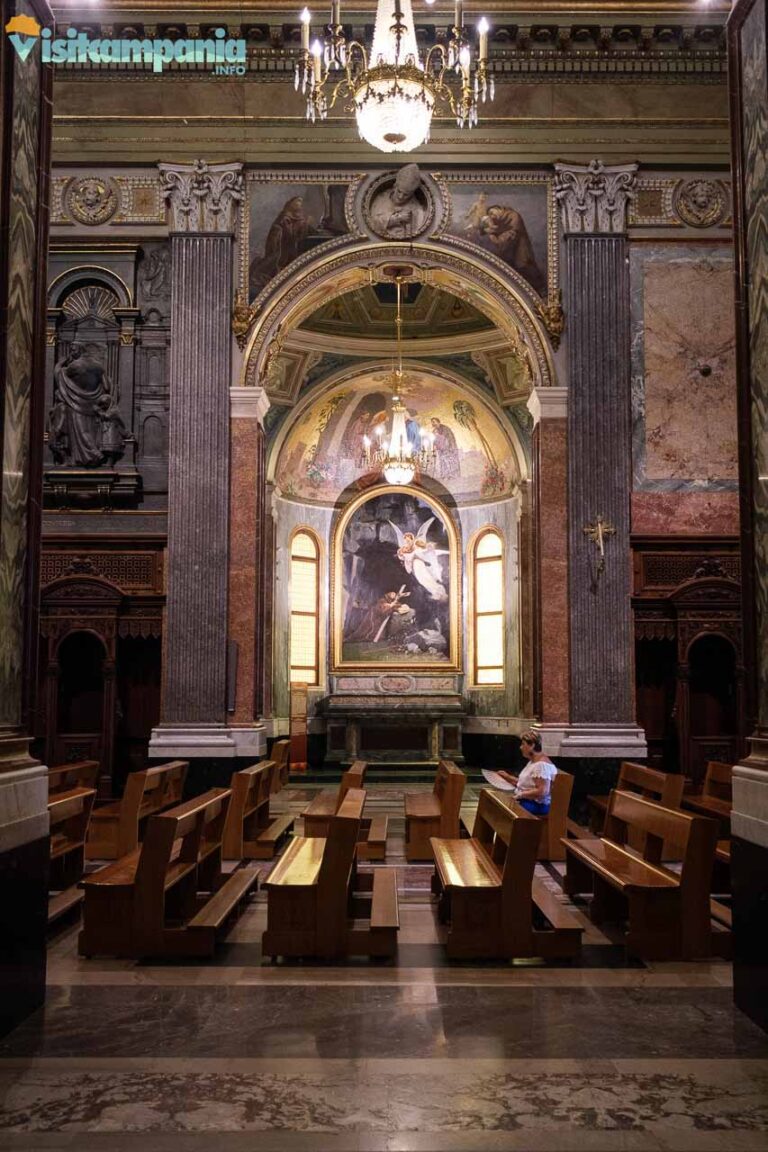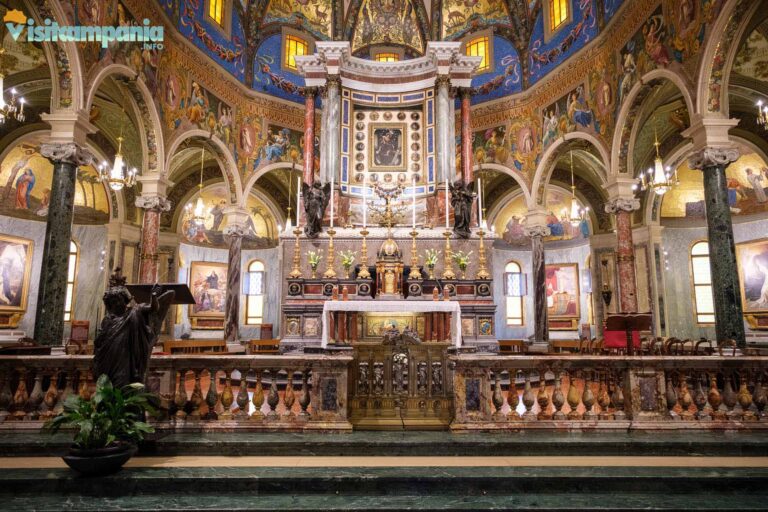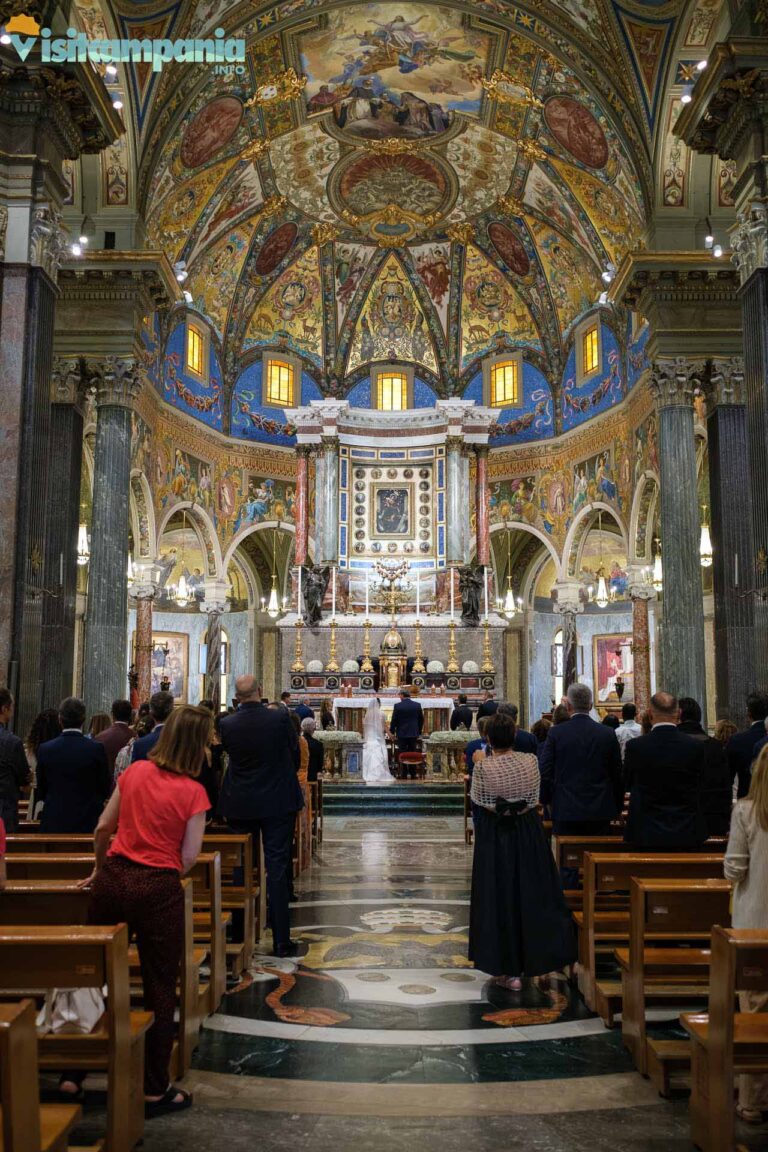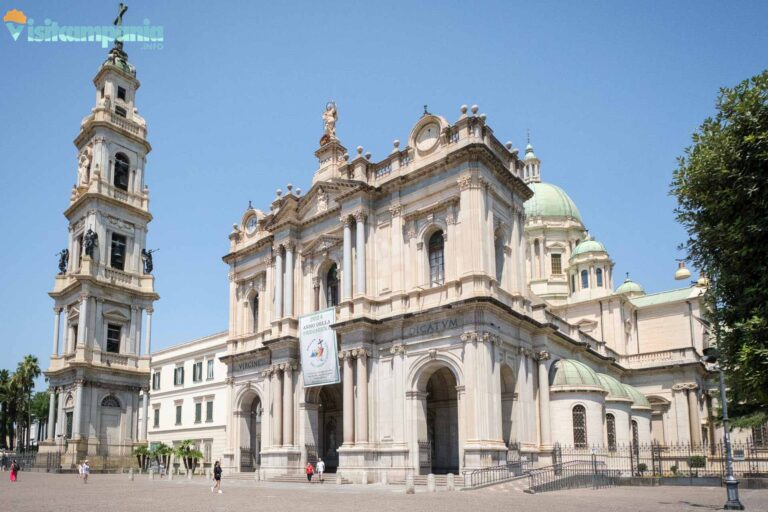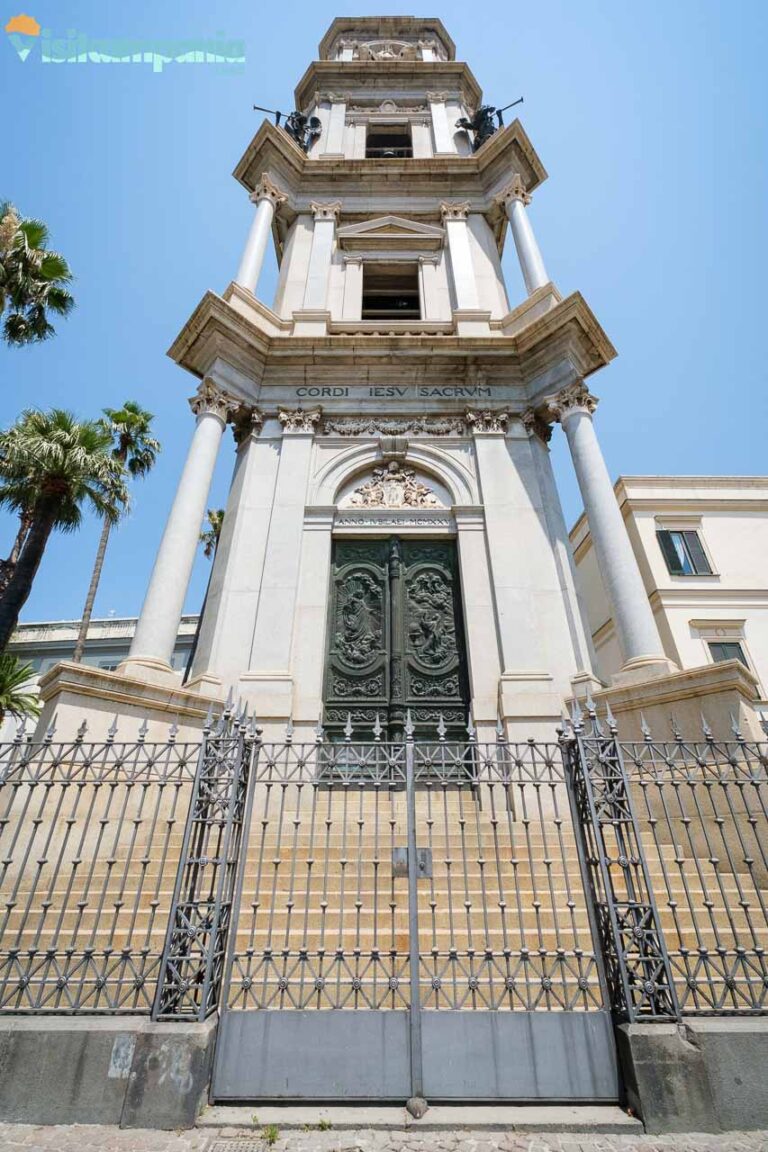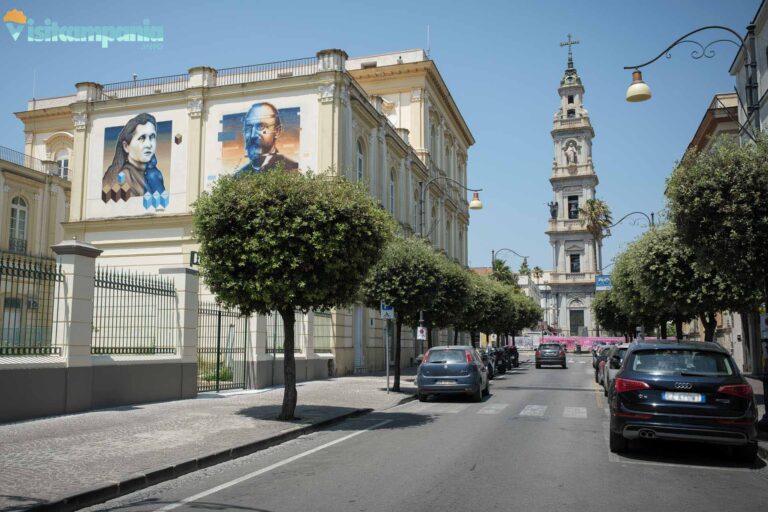What is the Sanctuary of the Blessed Virgin Mary of the Holy Rosary of Pompeii
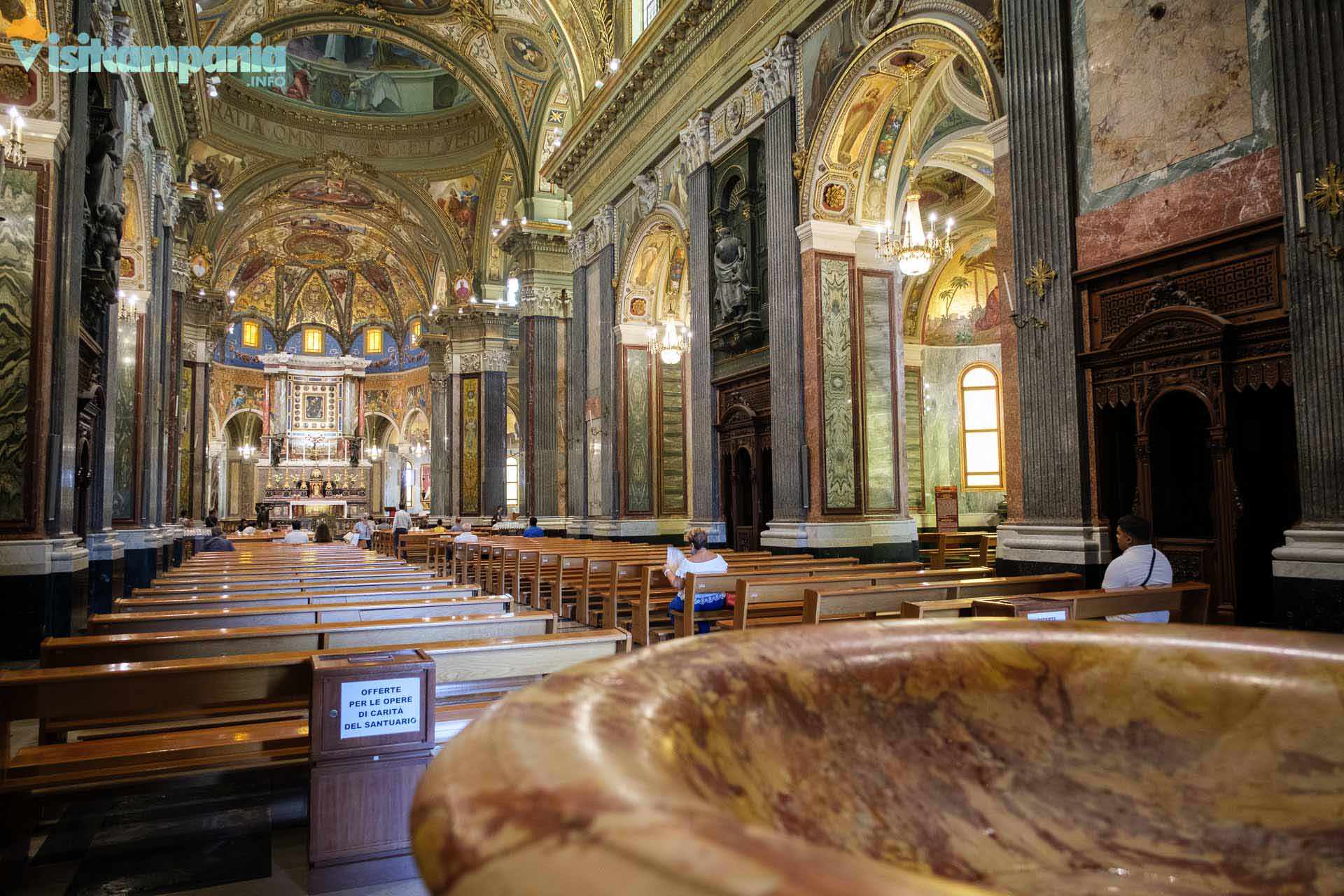 The Pontifical Shrine of the Blessed Virgin of the Holy Rosary in Pompeii is a Catholic place of worship and one of the most visited Marian shrines in Italy, with over 2 million visitors a year. Awarded the dignity of pontifical basilica, an honorific name granted by the Pope, it is also the cathedral of the territorial prelature and the seat of the pontifical delegation.
The Pontifical Shrine of the Blessed Virgin of the Holy Rosary in Pompeii is a Catholic place of worship and one of the most visited Marian shrines in Italy, with over 2 million visitors a year. Awarded the dignity of pontifical basilica, an honorific name granted by the Pope, it is also the cathedral of the territorial prelature and the seat of the pontifical delegation.
Brief history of the Sanctuary of Pompeii
Founded by Bartolo Longo and Marianna Farnararo de Fusco, the Sanctuary of Pompeii is a symbol of faith and charity. Begun in 1876, it was elevated to a major papal basilica in 1901 by Pope Leo XIII. Originally with a single nave, it was enlarged between 1934 and 1939 with two smaller naves, a crypt and a new dome. Despite the eruption of Mount Vesuvius in 1944 and the Nazi occupation, it has remained a hotspot for pilgrims from all over the world. Celebrations such as the Supplication to Our Lady of Pompeii, recited on May 8 and the first Sunday of October, underline its importance in the Marian tradition. The sanctuary has hosted illustrious visitors and saints, including St. Pio of Pietrelcina, St. Joseph Moscati, St. John Paul II, Benedict XVI and Pope Francis.
The Marian Mission of the Rosary
Pompeii, in addition to its extraordinary archaeological park, also stands out as an international center of spirituality of the Rosary . The Sanctuary, in fact, welcomes pilgrims from all over the world promoting the Marian Mission of the Rosary . Founded in the 1950s, it is based on Marian prayer and aims to bring the icon of the Blessed Virgin of the Holy Rosary to parish communities, promoting the contemplation of the mysteries of Christ through Mary. The core of the mission is to offer an experience of conversion, mission, service of charity and promotion of peace following the example of Blessed Bartolo Longo.
The founders of the Sanctuary of Pompeii
Blessed Bartolo Longo
Bartolo Longo was born on February 10, 1841 in Latiano (BR). After returning to the Catholic faith, in 1872 he settled in Pompeii where he promoted the Rosary as an instrument of salvation. He built the church dedicated to Our Lady of the Rosary and in 1875 received the image of the Virgin of the Rosary. In 1877 he promoted the Fifteen Saturdays and in 1879 he wrote the Novena to the Virgin of the Rosary of Pompeii. He founded the periodical “The Rosary and the New Pompeii” and contributed to the development of the community, with infrastructures such as houses, telegraph, railway station and hospital so much so that in 1928 Pompeii was recognized as an autonomous municipality. He founded kindergartens, oratories, the “Workers’ Houses”, the Female Orphanage and hospices for the children of prisoners. He died on October 5, 1926 and was beatified by John Paul II in 1980. Today, the educational centers of the Sanctuary of Pompeii continue its mission of assistance and formation for young people.
Countess Marianna Farnararo
Marianna Farnararo was born on December 13, 1836 in Monopoli. Orphaned since she was a child, she was educated in a religious institute and married Count Albenzio De Fusco in 1852, moving to Naples. After her husband’s death, she inherited properties in the Valley of Pompeii and asked for the help of Bartolo Longo to manage them. She collaborated closely with him in spreading the Rosary among the local peasants and, on the advice of Pope Leo XIII, married him in 1885. He dedicated fifty years to the spread of Marian worship, to the service of the Church and the marginalized, also contributing financially to the construction of the sanctuary. He built the Female Orphanage in 1887 and documented the origins of the Sanctuary of Pompeii in his “Pro Memoria – Notes on the origins of the Sanctuary of Pompeii”. He died in Pompeii on February 9, 1924, leaving a legacy of faith and dedication that endures to this day.
What to see at the Sanctuary of the Blessed Virgin Mary of the Holy Rosary of Pompeii
Although the Sanctuary has elements of architectural and artistic value, its importance is mainly linked to its nature as a place of worship and center of Marian devotion. For this reason, I preferred to give greater importance to the places and objects most relevant to the faithful and pilgrims, clearly dividing the places of the Spirit from the places of Art. With this necessary premise, let’s delve into the discovery of the Sanctuary of Pompeii.
The places of the Spirit
The painting of the Madonna
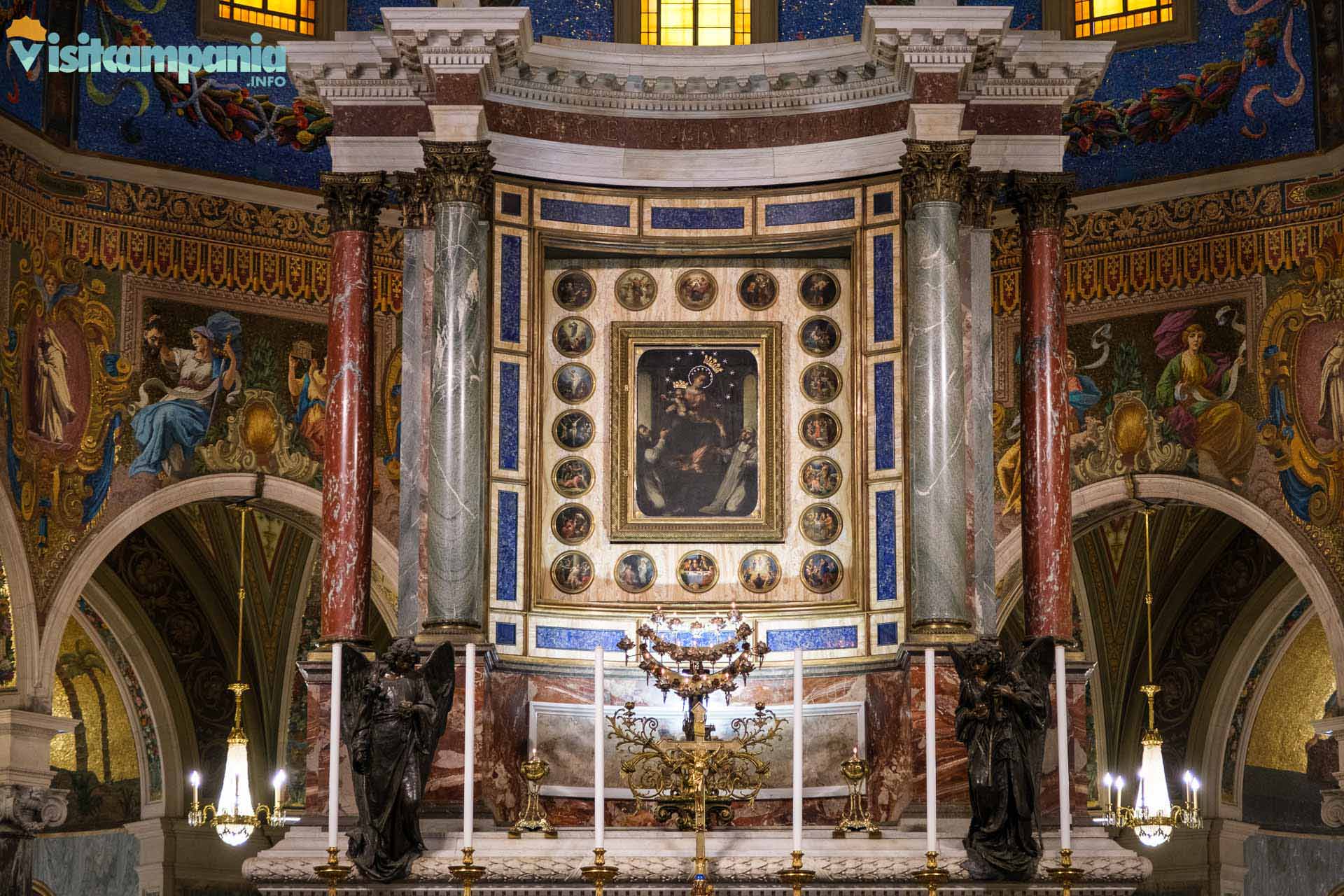
The painting of the Madonna displayed in the throne on the main altar is the main spiritual reference of the Sanctuary of Pompeii. Recovered by Bartolo in the Conservatory of the Rosary of Portamedina in Naples and brought to Pompeii on November 13, 1875, the painting was worn and in bad shape, with the Madonna offering the crown to Saint Rose instead of Saint Catherine of Siena. Restored several times , it has seen, among other things, the transformation of the figure of St. Rose into St. Catherine of Siena. Among all, the most significant restoration is that of 1965 which made it possible to recover the original colors and to eliminate almost all the precious stones affixed by the faithful for devotion in previous years. At the end of the restoration work, the icon was venerated for a few days in St. Peter’s Basilica and crowned by Pope Paul VI on April 23. In 2000, for the 125th anniversary, the painting was exhibited for five days in the Cathedral of Naples, venerated by thousands of faithful. In 2002, at the request of Pope John Paul II, the icon returned to St. Peter’s Square for the signing of the apostolic letter Rosarium Virginis Mariae. The icon depicts the Madonna enthroned with Jesus, St. Dominic and St. Catherine of Siena. It is set in a gilded bronze frame on an onyx background, surrounded by roundels representing the mysteries of the Rosary, joyful, glorious and sorrowful, and the luminous mysteries added by Saint John Paul II in 2002. In front of the Icon, 15 rose-shaped oil lamps burn constantly, a symbol of perpetual devotion .
The chapel of Blessed Bartolo Longo
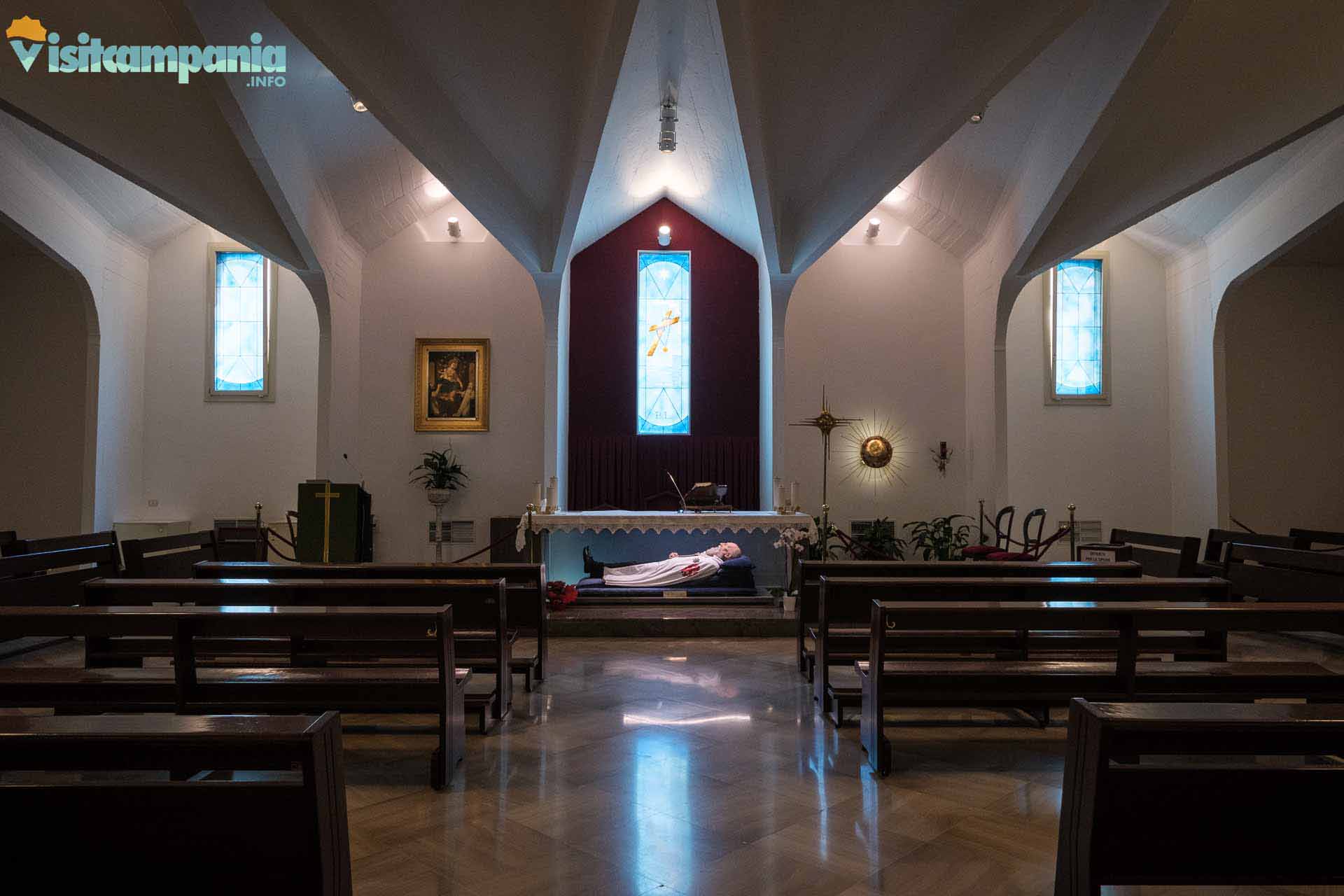 The Chapel dedicated to Blessed Bartolo Longo, adjacent to the Sanctuary, was built during the works for the Great Jubilee of 2000. Under the altar is an urn containing the remains of Blessed Bartolo Longo . Depicted in a resin simulacrum that preserves his mortal remains, he is dressed in a black suit and the cloak of the Knights of the Equestrian Order of the Holy Sepulchre of Jerusalem to which Bartolo Longo belonged.
The Chapel dedicated to Blessed Bartolo Longo, adjacent to the Sanctuary, was built during the works for the Great Jubilee of 2000. Under the altar is an urn containing the remains of Blessed Bartolo Longo . Depicted in a resin simulacrum that preserves his mortal remains, he is dressed in a black suit and the cloak of the Knights of the Equestrian Order of the Holy Sepulchre of Jerusalem to which Bartolo Longo belonged.
Bartolo Longo’s apartment
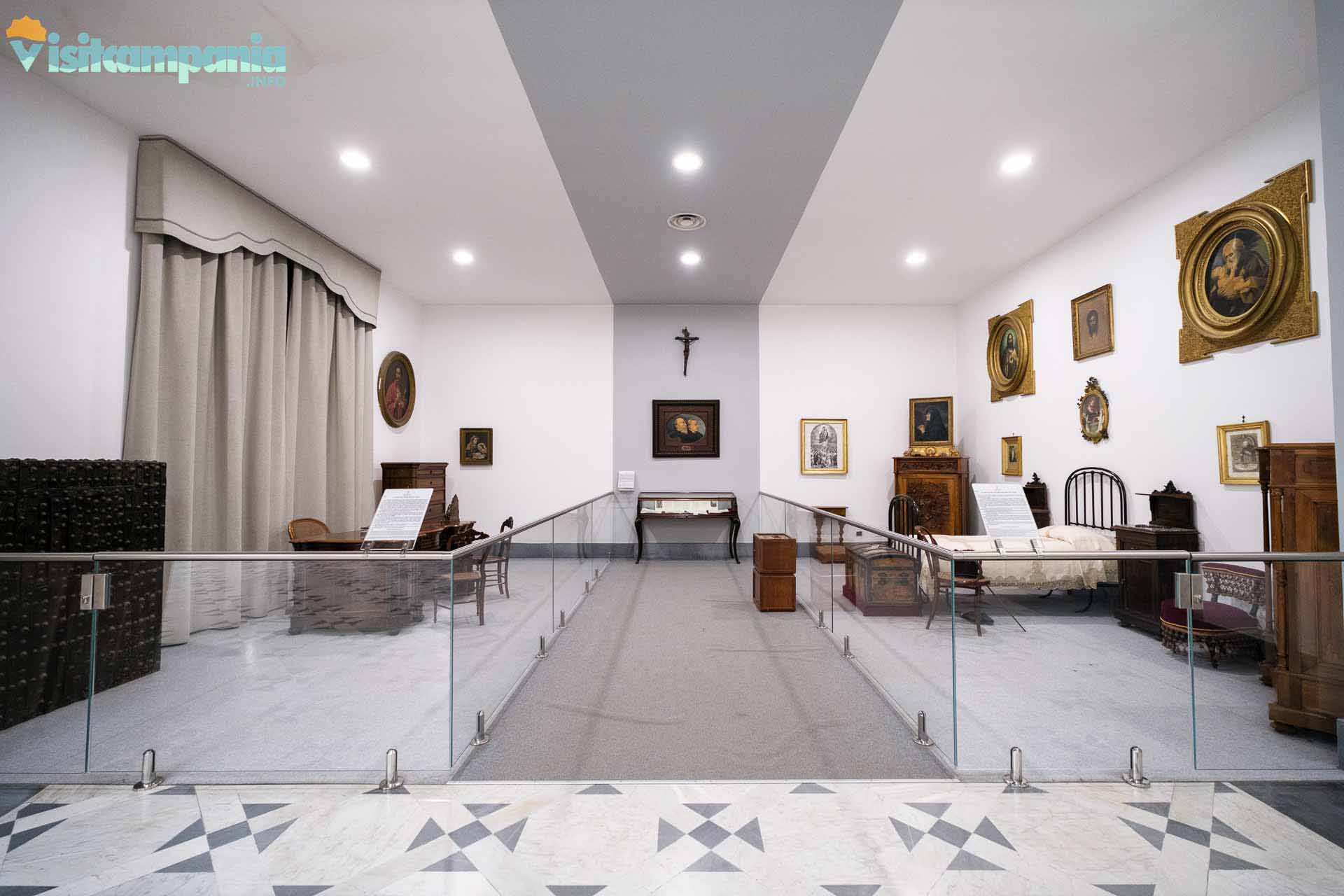 From October 5, 2018, visitors to the Sanctuary can explore Bartolo Longo’s study and bedroom. A copy of the first version of the Supplication composed in 1883 is exhibited here. The room is simple, with a bed, a few pieces of furniture, chairs and religious paintings. A kneeler for prayer, fundamental together with the daily Eucharist, completes the essential furnishings, reflecting its detachment from material goods. In the studio, he wrote many of his works, including “The Fifteen Saturdays of the Most Holy Rosary” and several novenas. Bartolo Longo died on October 5, 1926, at the age of eighty-five, on the bed now exposed in the hall.
From October 5, 2018, visitors to the Sanctuary can explore Bartolo Longo’s study and bedroom. A copy of the first version of the Supplication composed in 1883 is exhibited here. The room is simple, with a bed, a few pieces of furniture, chairs and religious paintings. A kneeler for prayer, fundamental together with the daily Eucharist, completes the essential furnishings, reflecting its detachment from material goods. In the studio, he wrote many of his works, including “The Fifteen Saturdays of the Most Holy Rosary” and several novenas. Bartolo Longo died on October 5, 1926, at the age of eighty-five, on the bed now exposed in the hall.
Crypt
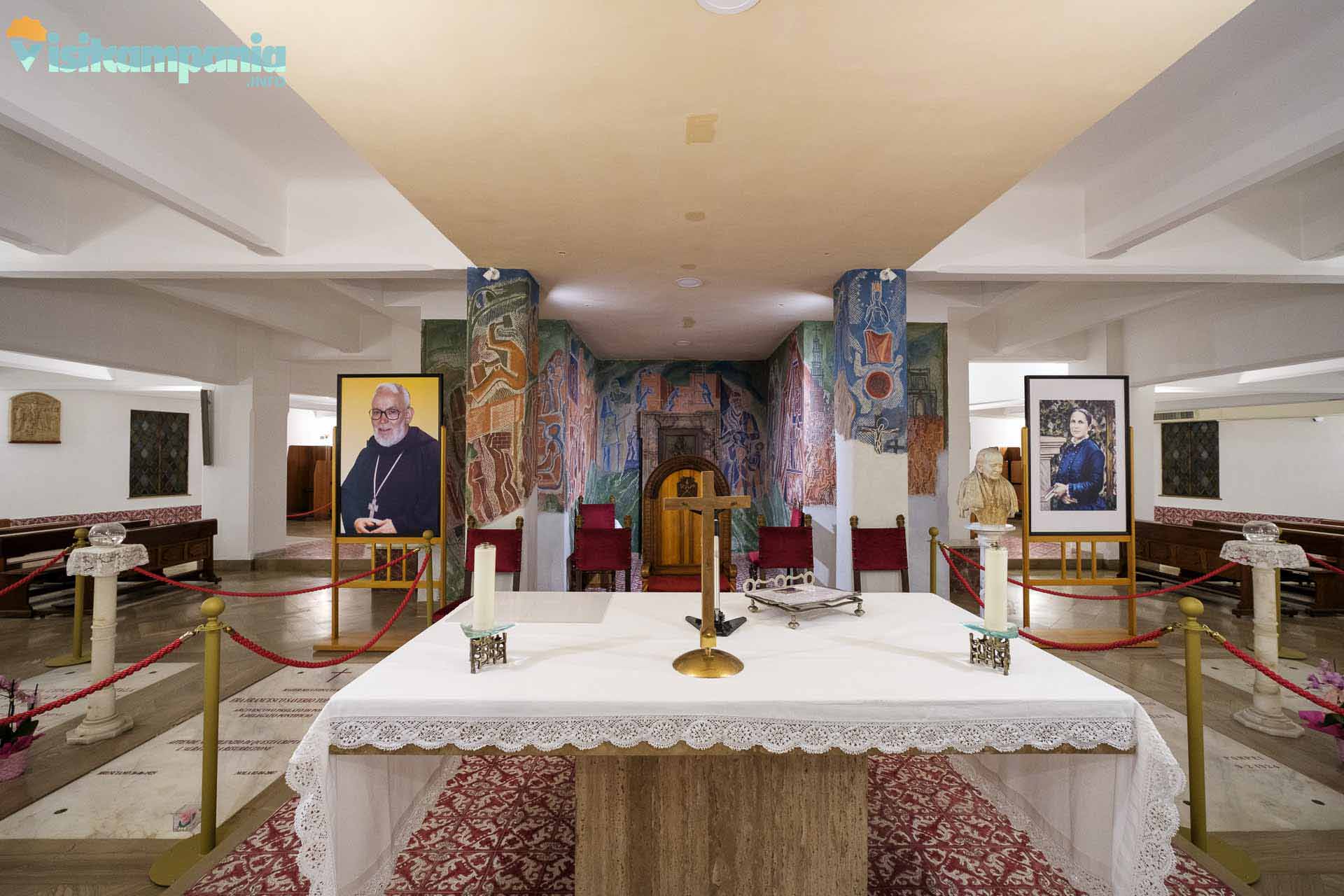 Another place of profound spiritual impact is the crypt of the Sanctuary. Created between the foundations after the expansion works in the thirties, it serves as a second sanctuary for masses and confessions. Here lie the remains of Countess De Fusco, Bartolo’s wife, of Father Alberto Radente, confessor of the Blessed, and of Sister Maria Concetta De Litala, original custodian of the painting of the Madonna given to Bartolo Longo in 1875. Since 2007, the crypt has also housed the Servant of God Francesco Saverio Toppi, Archbishop Prelate of Pompeii from 1990 to 2001, for whom the cause of beatification and canonization was opened in 2014.
Another place of profound spiritual impact is the crypt of the Sanctuary. Created between the foundations after the expansion works in the thirties, it serves as a second sanctuary for masses and confessions. Here lie the remains of Countess De Fusco, Bartolo’s wife, of Father Alberto Radente, confessor of the Blessed, and of Sister Maria Concetta De Litala, original custodian of the painting of the Madonna given to Bartolo Longo in 1875. Since 2007, the crypt has also housed the Servant of God Francesco Saverio Toppi, Archbishop Prelate of Pompeii from 1990 to 2001, for whom the cause of beatification and canonization was opened in 2014.
Ex voto
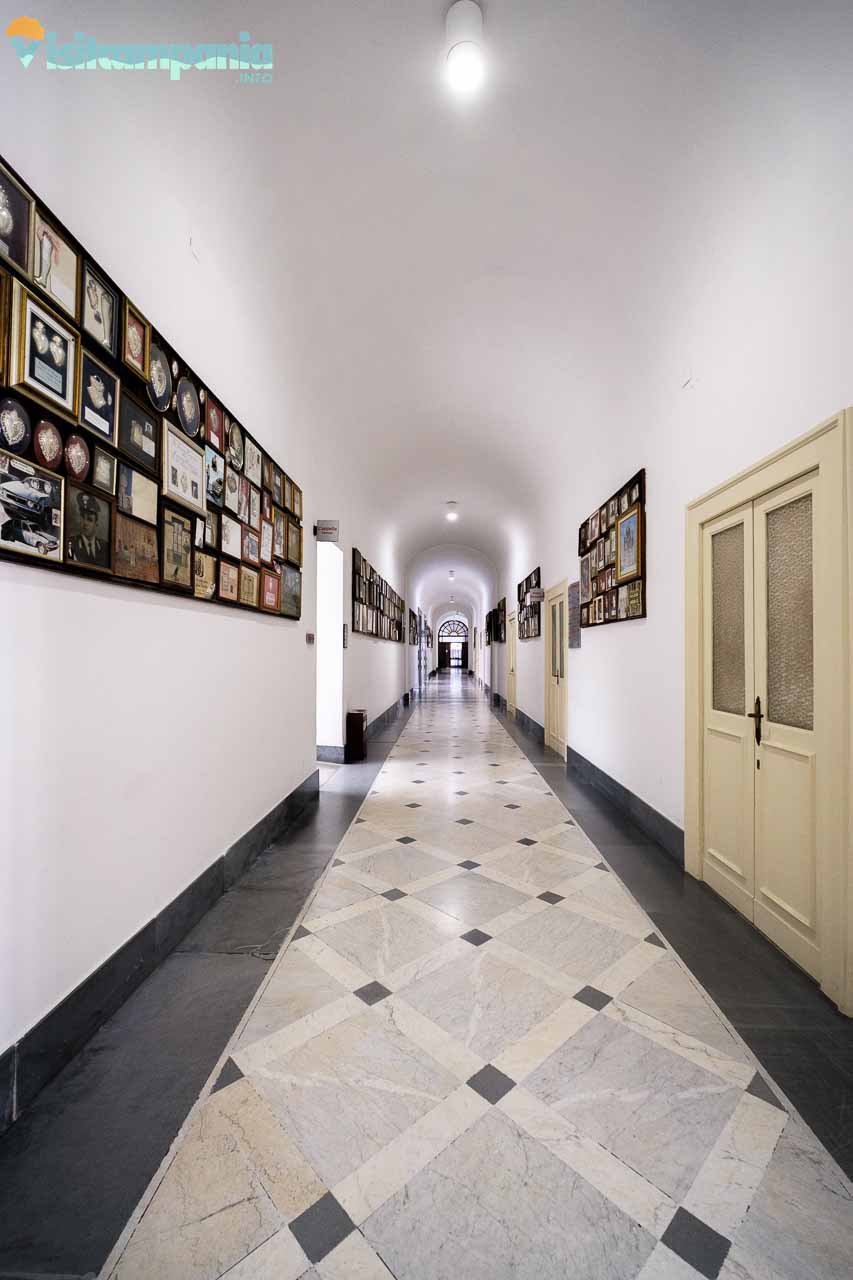
The rooms adjacent to the Sanctuary of Pompeii are organized into four large corridors that house numerous votive offerings, including paintings, compositions, objects, photographs and texts. These votive offerings are offered to God, the Virgin or a Saint as a thanksgiving for a grace received, often accompanied by the initials “V.F.G.A.” (Votum fecit, gratiam accepit). They testify to suffering overcome and gratitude for the prayers answered, making the miracles visible along the corridors of the sacred place.
The places of Art
The façade of the Sanctuary
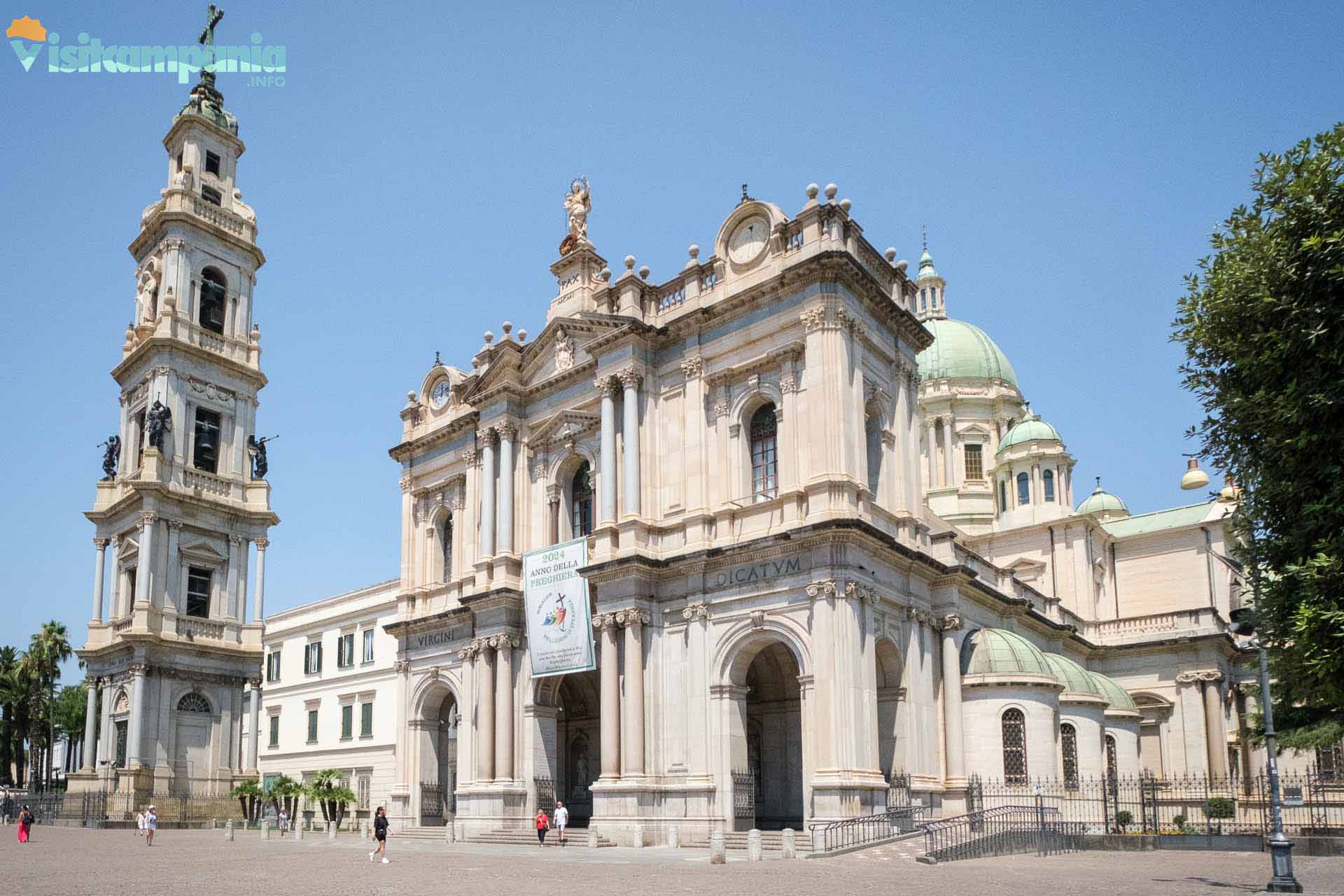 The Pontifical Shrine of the Blessed Virgin of the Holy Rosary of Pompeii is distinguished by its basilica facade inaugurated in 1901, characterized by two architectural orders – Ionic in the lower part and Corinthian in the upper part. The facade is enriched by a portico with four niches containing marble statues of Saints and an attic with a balustrade, clock, sundial and the central statue of the Virgin of the Rosary symbolizing Universal Peace.
The Pontifical Shrine of the Blessed Virgin of the Holy Rosary of Pompeii is distinguished by its basilica facade inaugurated in 1901, characterized by two architectural orders – Ionic in the lower part and Corinthian in the upper part. The facade is enriched by a portico with four niches containing marble statues of Saints and an attic with a balustrade, clock, sundial and the central statue of the Virgin of the Rosary symbolizing Universal Peace.
The interior of the Sanctuary
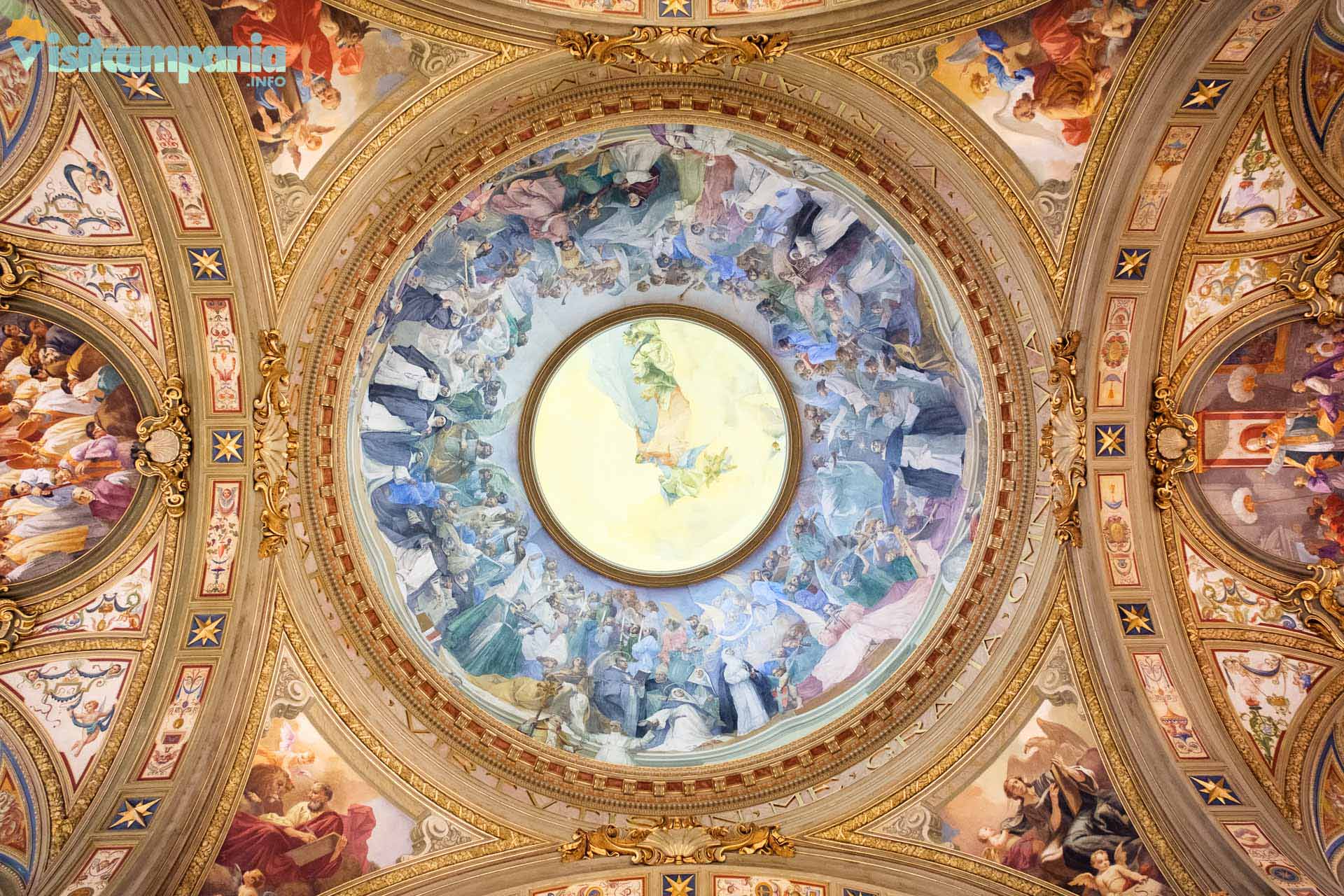
The interior of the Sanctuary welcomes visitors with frescoes, mosaics and polychrome marbles. The central nave is dominated by a monumental fresco on the vault and bronze statues of the Founders. The apse has marble columns and a fresco of the Assumption of the Virgin in the vault. The presbytery houses the high altar on a marble predella and the throne for the icon of the Madonna, the focal point of the Marian experience in Pompeii. The central dome , 57 meters high, houses a fresco representing the “Vision of San Domenico“. The side chapels, three on each side, are adorned with mosaics representing the mysteries of the Rosary and house six altars dedicated to figures of important saints. In the cross, two chapels stand out: the Chapel of St. Michael the Archangel on the left and the Chapel of St. Joseph on the right. Entering the Sanctuary, you pass under the choir loft decorated with sculptures and carvings in pure gold, supported by columns of green marble mottled with red, which encloses the main organ. Commissioned by Bartolo Longo, the original organ was installed in 1890 and rebuilt in 1952. It has 87 registers and 5624 pipes. Next to the high altar, another smaller organ was added in 2011.
Diocesan Museum
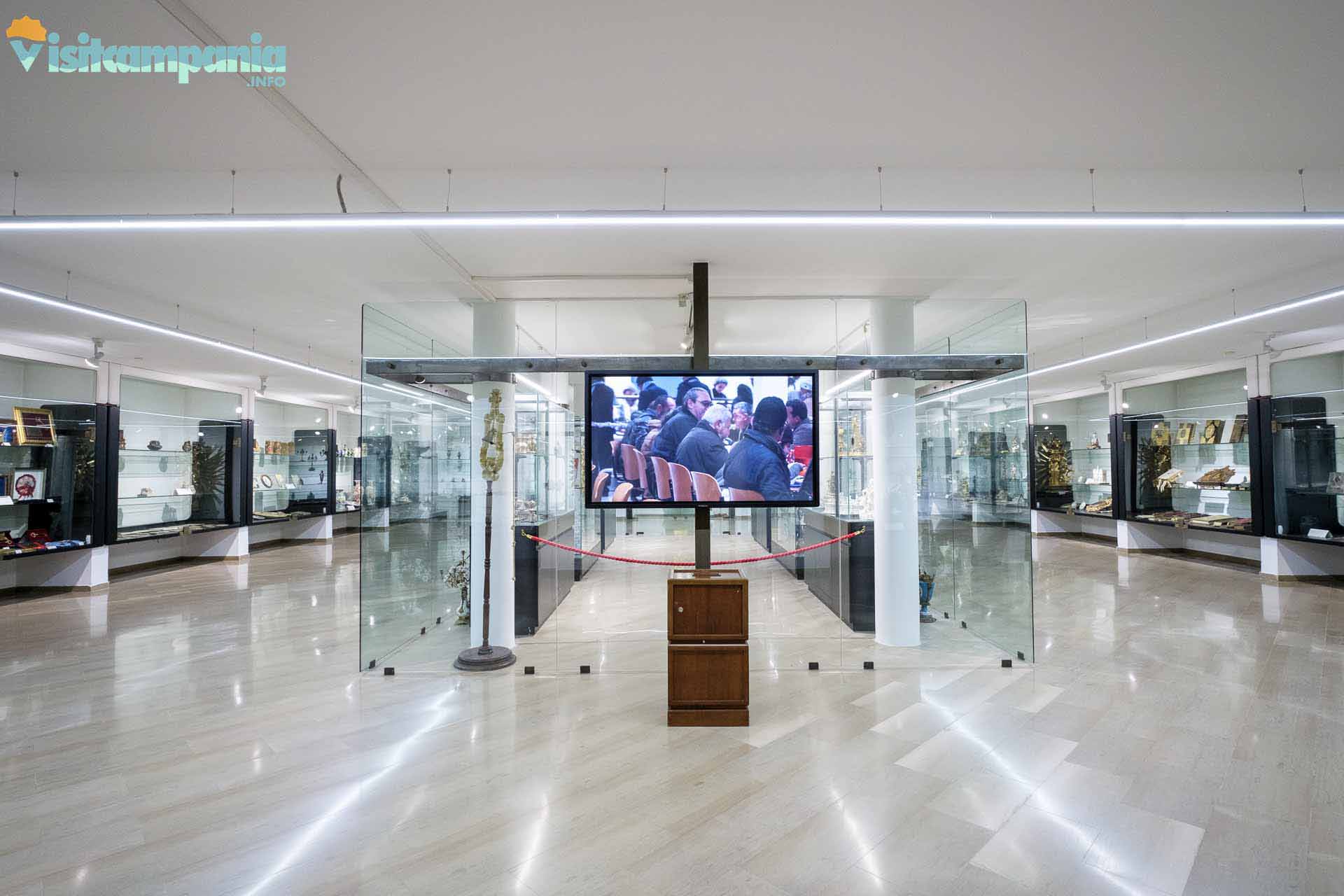 The Diocesan Museum of Pompeii was established in 1900. Enlarged and renovated in 1970 and 2000, it is located inside the Sanctuary in the basement of the east corridor. The collection includes silver, gold, liturgical furnishings, Capodimonte porcelain and other objects of great value. It can be visited every day from 8.00 to 13.30 and from 15.30 to 19.30.
The Diocesan Museum of Pompeii was established in 1900. Enlarged and renovated in 1970 and 2000, it is located inside the Sanctuary in the basement of the east corridor. The collection includes silver, gold, liturgical furnishings, Capodimonte porcelain and other objects of great value. It can be visited every day from 8.00 to 13.30 and from 15.30 to 19.30.
Bell tower
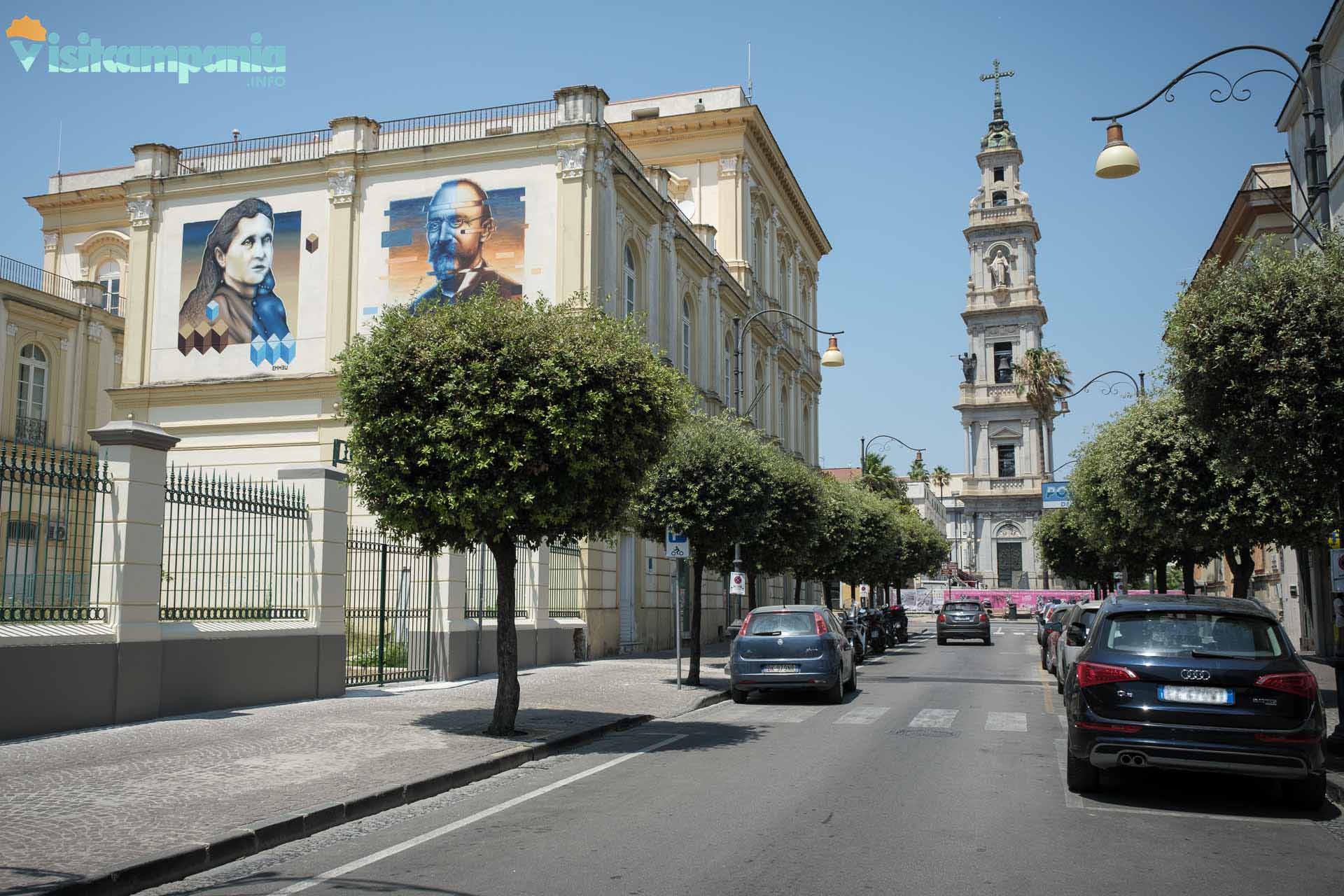
The bell tower of the Sanctuary, 80 meters high and surmounted by a dome with a jeweled cross in copper and bronze, was built between 1912 and 1925. It is spread over five overlapping orders and is decorated with bronze angels and a statue of the Sacred Heart of Jesus. It has eight bells, cast with bronze from war cannons, electrically operated. Restored after the 1980 earthquake, it offers a panoramic view of the gulf, the Apennines, the ruins of Pompeii, Vesuvius and the Sarno Valley, and is accessible by lift.


